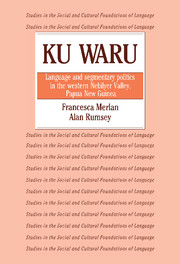Book contents
- Frontmatter
- Contents
- List of illustrations
- List of tables
- List of abbreviations
- Preface and acknowledgments
- 1 Introduction
- 2 The setting
- 3 Some aspects of Ku Waru segmentary sociality
- 4 Ceremonial exchange and marriage in the western Nebilyer Valley
- 5 Some linguistic structures of segmentary politics
- 6 Warfare compensation payment to Laulku: an analysis
- 7 Compensation at Palimung and the Kulka women's club
- 8 The events in perspective
- 9 Perspectives on ‘event’
- Appendix A Transcript of proceedings at Kailge on July 24, 1983
- Appendix B Grammatical sketch of Bo Ung, Ku Waru dialect
- Appendix C The conduct of warfare
- Appendix D Ku Waru metalinguistic expressions
- Chapter notes
- Glossary
- References
- Index
- Plate section
Appendix B - Grammatical sketch of Bo Ung, Ku Waru dialect
Published online by Cambridge University Press: 30 December 2009
- Frontmatter
- Contents
- List of illustrations
- List of tables
- List of abbreviations
- Preface and acknowledgments
- 1 Introduction
- 2 The setting
- 3 Some aspects of Ku Waru segmentary sociality
- 4 Ceremonial exchange and marriage in the western Nebilyer Valley
- 5 Some linguistic structures of segmentary politics
- 6 Warfare compensation payment to Laulku: an analysis
- 7 Compensation at Palimung and the Kulka women's club
- 8 The events in perspective
- 9 Perspectives on ‘event’
- Appendix A Transcript of proceedings at Kailge on July 24, 1983
- Appendix B Grammatical sketch of Bo Ung, Ku Waru dialect
- Appendix C The conduct of warfare
- Appendix D Ku Waru metalinguistic expressions
- Chapter notes
- Glossary
- References
- Index
- Plate section
Summary
Introduction
The following brief grammatical outline is provided to help the reader interested in examining the lines of Ku Waru text in Appendix A and Chapter 7. Ideally, those texts would include a third line of morpheme-by-morpheme glosses throughout, but length restrictions preclude that here. This outline is intended to facilitate the reader's efforts to identify noun and verb endings, and basic construction types at phrase and clause levels. Where possible, verb inflections are summarily presented as paradigms in tables. There is brief discussion of the meaning and functions of some categories of the noun and verb (especially the latter) where these would otherwise be particularly difficult to infer from the category labels alone. We include an inventory of Ku Waru phonemes, but only the briefest indications concerning pronunciation. Despite all its limitations, this outline should make the recognition of morphemes and construction types possible for the reader who wishes to use it as an aid in working through the texts included in this book.
While most of New Guinea's 700–1000 languages are spoken by fewer than 2000 people each, most of the 250,000 people in the Western Highlands Province speak dialects belonging to a single dialect continuum, which ranges east at least as far as Kujip, north to Ruti, west to the Kaugel Valley, and south to Ialibu in the Southern Highlands Province (see Map 1). People who live at extreme ends of the continuum cannot generally understand each other unless they have had enough exposure to become bi-dialectal. In the modern context, opportunities for such exposure have greatly increased.
- Type
- Chapter
- Information
- Ku WaruLanguage and Segmentary Politics in the Western Nebilyer Valley, Papua New Guinea, pp. 322 - 343Publisher: Cambridge University PressPrint publication year: 1991



